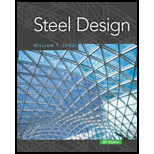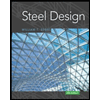
Bundle: Steel Design, Loose-leaf Version, 6th + Mindtap Engineering, 1 Term (6 Months) Printed Access Card
6th Edition
ISBN: 9781337761505
Author: William T. Segui
Publisher: Cengage Learning
expand_more
expand_more
format_list_bulleted
Question
Chapter 10, Problem 10.7.1P
To determine
(a)
The trial cross section for the design of a plate girder by using LRFD.
To determine
(b)
The trial cross section for the design of a plate girder by using ASD.
Expert Solution & Answer
Want to see the full answer?
Check out a sample textbook solution
Students have asked these similar questions
1. Calculate the ultimate load carrying capacity of the pile tip driven into the soil profile shown
below:
G.W.T.
45'
Qapp
Soft Clay:
Ysat 100 pcf
Cu 500 psf, ou = 0°
平
12' Soil
Plug
Driven Steel Pipe Pile:
Outside Diameter = 2'
Inside Diameter = 1'11"
Hollow (soil plugged)
Note: Pile & soil profile
are not drawn to scale
Qp = ?
Please perform the tip capacity calculation two ways: For the first approach, assume that the
total vertical stress at the pile tip is balanced by the weight of the pile. For the second
approach, assume that the total vertical stress at the pile tip is not balanced by the weight of
the pile (which means you need to include the vertical total stress term). Please compare
your answers from these two analyses, examine some of your intermediate-stage calculation
results such as the total overburden stress at the pile tip relative to the weight of the pile, and
discuss whether or not the commonly used assumption about the total vertical stress at the
pile tip is a…
A6.2- Given a simply supported beam with the typical
cross-section as shown in the figure below. Assume interior
exposure for this beam. The beam properties are summarized
below.
a) Check if the beam section satisfies the CSA A23.3 cracking
control requirements. In your calculations, find f, accurately
based on the loading, and compare the results with f = 0.6 fy.
b) Find the deflection due to DL+LL at mid-span after 6
years.
Given: Concrete: Normal density with f'c = 25 MPa
Reinforcement: Uncoated rebars with fy = 400 MPa
Shear reinforcement: 10M
Maximum aggregate size: 20 mm
Clear cover to the stirrup: 30 mm
Clear spacing between the bars
=
35 mm
35 mm
30 mm
m
WDL= 20 kN/m
WLL= 15 kN/m
抖抖
b=400 mm
As = 8-25M
Cross-section
h=500 mm
A5.1- An unbraced column shown in Figure 1, column A-B with square
cross-section is given. The column is subjected to
Dead load (unfactored): PDL = 3000 kN, MDL-top = 85 kN.m, MDL-bo
=
-DL-bottom
= 100 kN.m.
=
Assume the cross-section of column is constant from top to bottom, and all the
beams have width = 300 mm and height 350 mm. Using f'c = 25 MPa, fy =
400 MPa, design the column and determine the ties spacing and arrangement.
Use 25M or 30M bars for longitudinal reinforcement, and 10M bars for ties.
Assume clear cover to be 40mm.
The design p has to be between 0.01 and 0.02. Column maximum dimension
can be 500mm.
т
4.0m
7.0m
5.5m
+
6.5m
Figure 1
B
Chapter 10 Solutions
Bundle: Steel Design, Loose-leaf Version, 6th + Mindtap Engineering, 1 Term (6 Months) Printed Access Card
Knowledge Booster
Similar questions
- 7.43 Neglecting head losses, determine what horsepower the pump must deliver to produce the flow as shown. Here, the elevations at points A, B, C, and D are 124 ft, 161 ft, 110 ft, and 90 ft, respectively. The nozzle area is 0.10 ft². B Nozzle Water C D Problem 7.43arrow_forwardNOTE: Use areal methods only for V,M,N diagrams(Do NOT use the equations) (also draw the N diagram(s) for the entire structure)arrow_forwardNOTE: Use areal methods only for V,M,N diagrams(Do NOT use the equations) (also draw the N diagram(s) for the entire structure)arrow_forward
- NOTE: Use areal methods only for V,M,N diagrams(Do NOT use the equations) (also draw the N diagram(s) for the entire structure)arrow_forwardNOTE: Use areal methods only for V,M,N diagrams(Do NOT use the equations) (also draw the N diagram(s) for the entire structure)arrow_forwardNOTE: Use areal methods only for V,M,N diagrams(Do NOT use the equations) (also draw the N diagram(s) for the entire structure)arrow_forward
- NOTE: Use areal methods only for V,M,N diagrams(Do NOT use the equations) (also draw the N diagram(s) for the entire structure)arrow_forwardProblem 2: Use the table below to compute the coordinates of the centroid of area shown below. y – 3 in.—|— 4 in. - -3 3 in. 3 in. x Area X X * Area y Y * Area Component (in²) (in) (in³) (in) (in³) Square 1 Rectangle 2 Triangle 3 Rectangle 4 Σarrow_forwardA shallow foundation measuring 1 m × 2 m in plan is to be constructed over a normally consolidated sand layer. Given: D₁ = 1 m, №60 increases with depth, N 60 (in the depth of stress influence) = 11, Estimate the elastic settlement using Burland and Burbidge's method. (Enter your answer to three significant figures.) Se mm and Inet = 138 kN/m².arrow_forward
- A continuous foundation on a deposit of sand layer is shown in the figure below along with the variation of the cone penetration resistance qc 1.5 m 0 2.5 m Sand 14 q= 195 kN/m² qe (kN/m²) 9 1750 93450 9c=2900 Depth (m) Assuming = 16 kN/m² and creep is at the end of ten years after construction, calculate the elastic settlement of the foundation using the strain influence factor method. Use the equations 22 Iz Es 0 | Se = C₁C2 (9) Az and Es = 3.5qc (for L/B> 10) (Enter your answer to three significant figures.) Se = mmarrow_forwardDetermine the stiffness matrices for the entire truss in the global co-ordinate system. Assume A=0.0015m2 and E=200GPa, indicate the degrees of freedom in all stiffness matricies.arrow_forwardneed helparrow_forward
arrow_back_ios
SEE MORE QUESTIONS
arrow_forward_ios
Recommended textbooks for you
 Steel Design (Activate Learning with these NEW ti...Civil EngineeringISBN:9781337094740Author:Segui, William T.Publisher:Cengage Learning
Steel Design (Activate Learning with these NEW ti...Civil EngineeringISBN:9781337094740Author:Segui, William T.Publisher:Cengage Learning

Steel Design (Activate Learning with these NEW ti...
Civil Engineering
ISBN:9781337094740
Author:Segui, William T.
Publisher:Cengage Learning